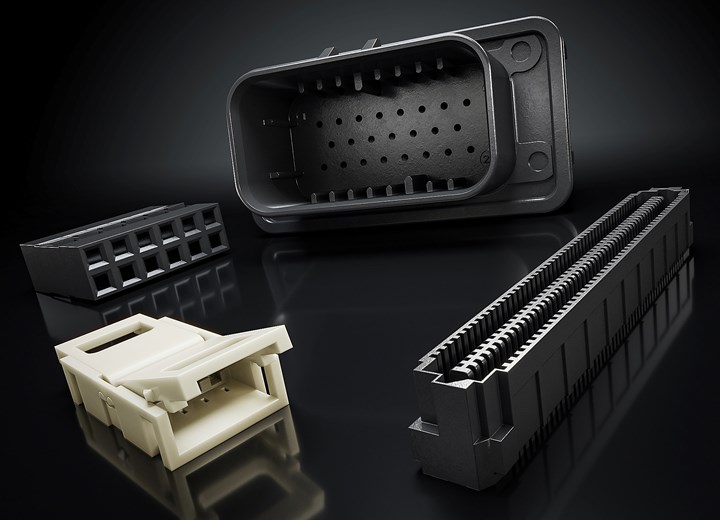Flame-Retardant PPAs for Electronic Components
BASF’s newly expanded Ultramid One J and Ultramid Advanced slate of FR PPA compounds boasts long-term thermal stability without corrosion.
A newly expanded slate of flame retardant PPA compounds for electronic components said to combine high thermal stability with excellent electrical insulation and low water uptake has been launched by BASF. The new Ultramid One J and Ultramid Advanced grades are characterized by high electrical RTI (relative thermal index) values above 284 F while being halogen-free according to EN 50642, thus preventing corrosion and failure of electrical parts when used under moist conditions.

The non-halogenated PPAs based on nylon 9T, nylon 66/6T, nylon 6T/66 and nylon 6T/6 reportedly also allow for better colorability and long color stability. With these new grades, BASF offers a tailored E&E portfolio which opens new possibilities for applications like connectors for power or data transmission in vehicles, appliances and consumer electronics as well as for e-mobility parts, miniature circuit breakers, switch gear and sensors. The UL cards for the four new PPA grades show excellent electrical RTI values and offer diverse performance levels for different part requirements.
The product range includes the easily processable Ultramid One J 60X1 V30, a nylon 66/6T acquired from Solvay and now available globally to customers from BASF. Together with the PPA pioneer Ultramid TKR 4340G6 nylon 6T/6, it is said to not only offer the highest electrical RTI value of 320 F but also very easy processability.
The nylon 9T Ultramid Advanced N3U41G6 shows an electrical RTI of 302 F at extremely low water uptake, which is crucial for SMT (surface mount technology) processing. Its outstanding chemical resistance combined with reportedly the most stable mechanical performance of all PPAs at elevated temperatures make it especially suitable for electronic applications. Ultramid Advanced T2340G6 is a nylon 6T/66 with very good flowability with an electrical RTI of 302 F and ideally suited for e.g. wire-to-board and board-to-board connectors.
All the flame retardant materials in the PPA portfolio are said to keep their high mechanical and dielectric strength at elevated temperatures. They show very good dimensional stability due to low and slow water uptake as well as a low coefficient of thermal expansion. They allow for V-0 rating at thicknesses down to < 0.4 mm and are in agreement with the cable management standard CMS EN 50654 (2018-05). The PPA portfolio is available globally and complemented by BASF’s Ultrasim simulation tool and extensive experience in application development. It includes more than 50 compounded grades for injection molding and extrusion, products with or without flame retardants. The compounds are available in different colors, from colorless to laser-markable black, with short-glass, long-glass or mineral fiber reinforcement, and with various heat stabilizers.
Related Content
-
Tracing the History of Polymeric Materials, Part 26: High-Performance Thermoplastics
The majority of the polymers that today we rely on for outstanding performance — such as polysulfone, polyethersulfone, polyphenylsulfone and PPS — were introduced in the period between 1965 and 1985. Here’s how they entered your toolbox of engineering of materials.
-
Automotive Awards Highlight ‘Firsts,’ Emerging Technologies
Annual SPE event recognizes sustainability as a major theme.
-
Prices Up for All Volume Resins
First quarter was ending up with upward pricing, primarily due to higher feedstock costs and not supply/demand fundamentals.














